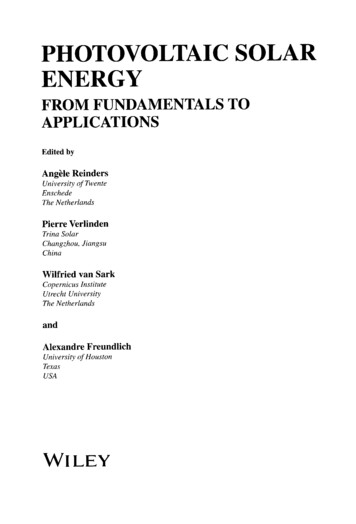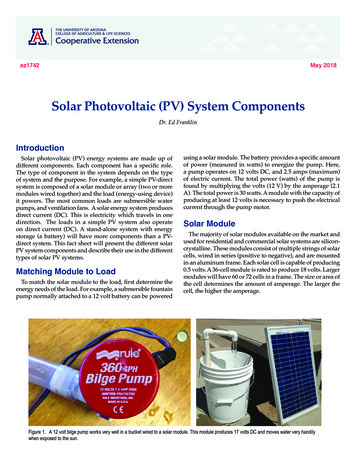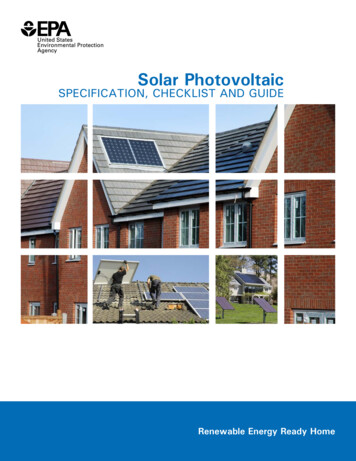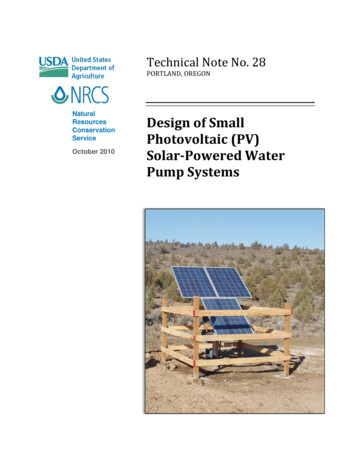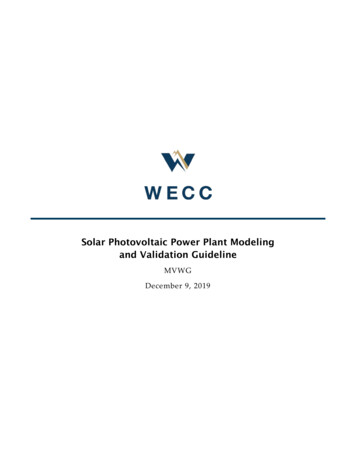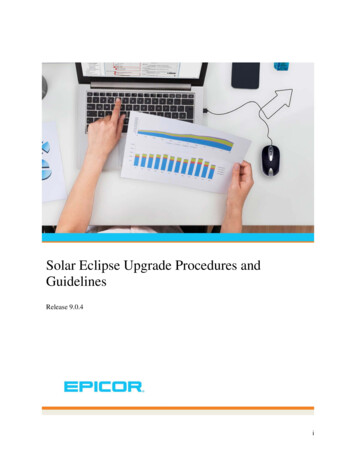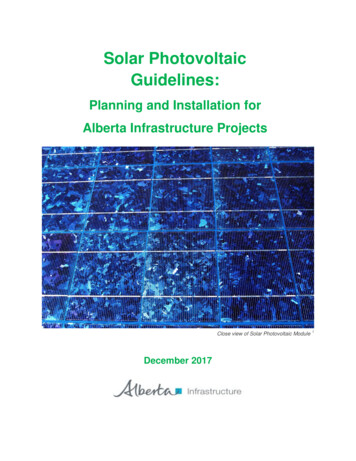
Transcription
Solar PhotovoltaicGuidelines:Planning and Installation forAlberta Infrastructure ProjectsClose view of Solar Photovoltaic ModuleDecember 20171
Solar Photovoltaic GuidelinesContentsExecutive Summary . 21.Introduction . 42.Solar Photovoltaics . 43.2.1.What are Solar Photovoltaics? . 42.2.Solar Photovoltaic Technology . 62.3.Inverter Technology . 7Designing with Solar Photovoltaic. 83.1.Technical Design Requirements . 83.2.Sustainability. 83.3.Leadership in Energy and Environmental Design . 93.4.Zero Carbon .103.5.Durability.103.6.Community Engagement .104.Initial Assessment .115.Solar PV Feasibility Study .146.5.1.Building Description .155.2.Measurement & Modeling of Solar Potential .155.3.Building Solar PV System Design Requirements .165.4.Safety .22Financial Requirements .246.1.Lifecycle Cost Analysis .246.2.Operation and Maintenance .257.Permits and Compliance: .268.Solar PV Component Manufacturer and Contractors .289.8.1.Component Manufacturer .288.2.Solar PV Installation Contractor .29Performance Monitoring .29References .30Appendix ANREL Description of Maintenance Services for Commercial Rooftop Installations .341
Solar Photovoltaic GuidelinesExecutive SummaryThis guideline serves to facilitate the incorporation of Solar Photovoltaic (PV) systems intoGovernment of Alberta new construction or renovation projects, as well as PV retrofits. Thefocus is to provide design and technical information to project managers and project teams topromote informed design decisions in the interest of developing best practices for solarphotovoltaic systems. The intention of this guideline is to encourage the reduction ofgreenhouse gas (GHG) emissions while enhancing project longevity and sustainability.Solar PV systems are versatile in their application, and wherever solar exposure permits,can be incorporated onto a facility’s roof, walls, windows, cladding, awnings, parking canopies,artwork, or other site features. As the technology continues to advance, new and innovativeapplications will become available and costs will continue to decrease. While this guidelineprimarily focuses on rooftop PV systems, many of the same considerations apply to wall orground mount installations.Designing with PVTo determine the viability of a proposed PV system design, several considerations are to beexamined including coordination with the Technical Design Requirements for AlbertaInfrastructure Facilities (TDR,) including Appendix ‘G’, (Green Building Standard), which lays outthe approach for the building certification Leadership in Energy and Environmental Design(LEED).This guideline describes the general process including the initial assessment, PV feasibilitystudy, and financial requirements. It also outlines the permit requirements, performancemonitoring, PV manufacturers and contractors, as well as a reference section for support andtechnical resources. What are yourproject goals. Does solar PV makesense for yourproject?InitialAssessmentFeasibiltyStudy Know your building! Understand theoptions. What is required toachieve your goals? Understand the fullcosts. What funds areavailable?FinancialRequirements2
Solar Photovoltaic GuidelinesThe feasibility study covers the design aspects to be assessed during the pre-planningphase. This evaluation will determine the viability of the PV system, with each element beingdeveloped and implemented through the design, construction and operations phases of theproject. These design aspects include: Building description: type, size, height, age, and use; Measuring and modeling solar potential, including understanding the effects of tile angleand azimuth as well as understanding the shading effects of trees, buildings and snow;and Project-specific PV design considerations: architectural, structural, mechanical,electrical, roofing, and safety requirements for building mounted PV arrays.Financial requirements include life-cycle costing (LCC), operations, and maintenance. Thecosts should include any green power purchased for the building’s electricity consumption.Fundamental Principles Work as a collaborative team to coordinate design decisions and all of the project’srequirements of each discipline;Safety for occupants, maintenance workers, installers, and first responders isparamount;Design for optimal energy efficiency in the building design, prior to the inclusion of solarPV system;Design for optimal energy generation and reduction of GHG emissions, withoutcompromising functionality or durability; andRoofing maintenance, durability, access, safety, and warranty eligibility should not beundermined by the solar PV installation.3
Solar Photovoltaic Guidelines1. IntroductionRenewable energy sources contribute to the environmental, economic, and socialdevelopment of Alberta communities. The Pan-Canadian Framework sets a goal for provincesand territories to adopt a “net-zero energy ready” model building code by 2030. This is a broadreaching goal with significant impact on the project design requirements. The Government ofAlberta is committed to the reduction of GHG emissions in the province from improved energyefficiencies, renewable energy sources, and the potential for long term operational efficienciesresulting from these strategies. The focus of this guideline is to inform decisions regarding solarphotovoltaic (PV) systems, thereby supporting the Government’s Climate Leadership Plan toreduce GHG emissions.This guideline is targeted to project managers, consultants, and contractors involved inAlberta Infrastructure projects who are evaluating the potential for a solar PV system. Thisincludes projects in the planning, design, or construction phases, as well as existing buildings.This guideline is structured to provide basic background information regarding how solar PVtechnology works and how it relates to the Sustainability section of the TDR including the GreenBuilding Standards. It offers advice on how to determine if a PV system is appropriate for aproject and, if so, how to manage the integration of a PV system into a project, with the keyimplications outlined for each relevant discipline.Solar PV technology has been around since the 1950s and, as a result, the body ofresearch is vast and ever expanding. The technology has been deployed largely in the UnitedStates and Europe over the last 20 years, and in Ontario over the last 10 years. Links todocuments and a Reference/Resource Appendix have been provided to support the informationherein. This Guideline will be updated regularly as new data is accrued and lessons learnedbecome available.2. Solar Photovoltaics2.1. What are Solar Photovoltaics?Solar photovoltaic systems are a safe andreliable technology that converts sunlight toelectricity. As energy and cost efficiencies haveimproved, the adoption of PV systems hasbecome increasingly prevalent.A solar PV system may be a single PVmodule connected to an inverter and othersupport equipment, but typically several PVmodules are structurally combined to make asolar PV panel. Several solar PV modules areelectrically combined to make a string. Severalpanels and strings are combined to make into asolar PV array. Solar PV arrays are the primaryconfiguration for installations at all scales.4
Solar Photovoltaic GuidelinesSolar PV technology can be applied in numerous ways and at varying scales, from that of ahandheld device to utility sized PV farms. The scope of this Guide is specific to AlbertaInfrastructure facilities, where PV arrays are primarily installed on top of a flat roof or onto a wall.Building Integrated Photovoltaics (BIPV), whereby PV cells or modules are incorporated intobuilding cladding such as in wall assemblies, roof shingles, or windows, may also beappropriate for some projects. Some considerations for determining if an attached PV array or aBIPV array is most appropriate include building configuration, orientation, available roof, walland ground area, cost, system efficiency, and the overall goals of the project.Solar PV system components and labourPV Covered Bike Lane32Wearable PVBIPV Roof ShinglesPV Integrated into Public Art64Free Standing PV Array57BIPV Window Application8The solar PV technology selected and the type of design (attached or building integrated)should be based on both the funding available and the project’s charter intentions, as theseselection decisions will affect the PV system cost and energy generation.5
Solar Photovoltaic GuidelinesSolar Photovoltaic TechnologyCommercially-available cell technologies primarily include mono-crystalline and multicrystalline silicone (c-Si). Additionally, there are emerging technologies of thin-film amorphoussilicon (a-Si, TF-Si), cadmium telluride (CdTe) and copper indium gallium selenide (CIS/CIGS).Most Common Crystalline Cells9Flexible AThe table below compares the performance and benefits of each technology as publishedon the Energy Informative website as of September 2013. Note that while mono-crystallinepanels are the most efficient option in both efficiency and size, they are also the most expensiveoption.Typical moduleefficiencyBest researchcell efficiencyArea requiredfor 1 kWpTypical lengthof warrantyLowest IGS6-8%9-11%10-12%25.0%20.4%13.4%18.7%20.4%6-9 m28-9 m213-20 m211-13 m29-11 m225 years25 years10-25 years0.75 /WPerformancedrops 10-15%at hightemperaturesand isincreased 1825% at lowtemperatures.Oldest celltechnologyand mostwidely used0.62 /WLesstemperatureresistant thanmonocrystalline0.69 /WToleratesextreme heatLess siliconwaste in theproductionprocessTend to degrade faster than crystalline-basedsolar cellsLow availability on the marketRelatively low impact onperformanceModified from: -chart-mono-polycrystalline-thin-film/Consider durability and available warranties when selecting the appropriate PV modules fora project. The long-term performance and warranty should be assessed in accordance with theproject’s charter and the client’s operational and maintenance requirements. Review PV modulecapacity, other electrical components (e.g. inverter), and installation processes for the entire PVsystem. Ensure existing (if applicable) and new elements are compatible, and that new orreplacement parts are readily available.6
Solar Photovoltaic Guidelines2.2. Inverter TechnologyThe electricity generated by the solar PV panels is direct current (DC) while the electricitygrid and building electricity are alternating current (AC). This requires the electricity to beinverted before it can be used in the building. There are two main types of inverters which haveimpacts on system performance: String (central) inverter systems; and Module-Level Power Electronics.String (central) inverter systems are the solar PV connected in series. The total circuitvoltage from the string is delivered to a single inverter. String Inverter Systems are suited forprojects where the solar PV is installed along a single plane without any shading as the circuitconnected to the central inverter will only produce as much electricity as its least productivepanel.Module-Level Power Electronics (MLPE) are installed on each individual panel, whichavoids the scale of the power reductions from shading. This results in a slight increase in powerproduction; however, there is an associated increased initial cost. Additionally, these systemsdo
Solar PV technology can be applied in numerous ways and at varying scales, from that of a handheld device to utility sized PV farms. The scope of this Guide is specific to Alberta Infrastructure facilities, where PV arrays are primarily installed on top of a flat roof or onto a wall. Building Integrated Photovoltaics (BIPV), whereby PV cells or modules are incorporated into building cladding .
